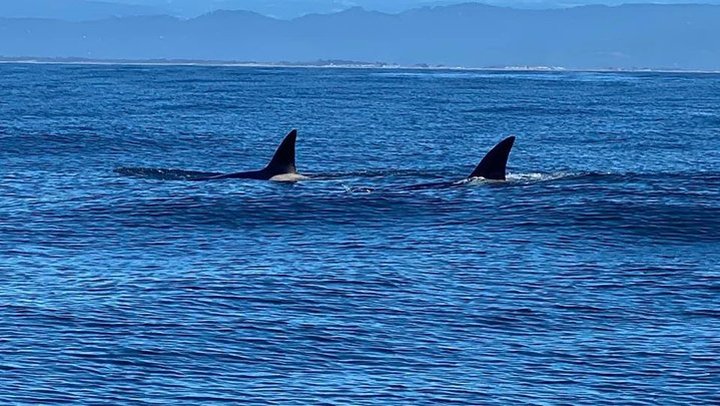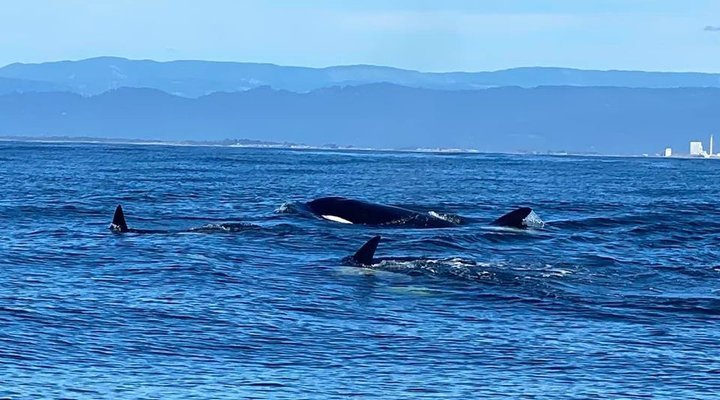Jacobsen’s recordings from yesterday. (Note: the final 8 seconds of the audio are of whales recorded on Friday, a few miles from the mouth of the Mad River.)
After hearing that a rare pod of orcas was spotted off the coast of the Samoa Peninsula last week, local marine biologist and whale expert Jeff Jacobsen has spent his subsequent days on the ocean, searching for whales, collecting data and recording the sounds of the deep on his fancy underwater microphone.
The whines, whistles and squawks that Jacobsen picked up on his hydrophone yesterday, he says, are the distinct calls of transient killer whales, a group mammal-eaters that are especially rare to Humboldt waters, but have been active along the North Coast in recent weeks.

A pod of orcas spotted near Humboldt Bay (Samoa and Manila in the background). | Photos by Ishan Vernallis and Robin Brown.
“They’re called ecotypes,” Jacobsen told the Outpost. “They’re not a different species, but have different diets, vocalizations and behaviors than the resident salmon eaters.”
These carnivorous whales are usually quiet when traveling and hunting to avoid being detected by prey, but can often be heard vocalizing after a kill.
“It’s always startling [and] astonishing to hear killer whale calls, especially the mammal-eating transients, which don’t vocalize as often as the fish eaters,” he said. “Yesterday [a local fisherman] called me on the radio saying that he’d just seen three orcas: two females and a male. He gave me the coordinates, west-southwest of the jetties in 180-foot depth, and we headed that way, stopping to listen via hydrophone as we went.”
A guest lecture given by Jacobsen for a College of the Redwoods marine biology class.
Thanks to the help of marine biologists like Jacobsen, these transient killer whales can often be identified by their dorsal fins, flukes, unique markings and even their calls. Because of this, the pod seen by numerous boaters along the Samoa Peninsula last week has been identified as pod T038, also known as “the T-38s,” a family of transient killer whales from British Columbia and Alaska, that, until last week, had never been seen south of Washington state.

“This is the first time [the pod] has been seen in California,” he said. “It astounds me that after 42 years of doing this research, we know so much about these killer whales. We know their ages and who’s related to who.”
Pod T038, like most transient orca pods, is a small group led by its grandmother of the same name. Years of research has revealed that killer whales are matriarchal in nature and their groups often split along matrilines when daughters and granddaughters have kids of their own. These small pod sizes and strong family bonds have allowed biologists to extensively study their distribution, lineage and social structures.
“Killer whales are intensely social and matriarchal,” Jacobsen said. “The matriarch grandma of another pod named T035 was seen traveling with the T-38s [in Humboldt], while her daughter and three grandkids were somewhere else, or here but not seen. Ever the soap opera mystery with Orcas. Highly social, huge brains, long lives.”
Jacobsen is encouraging anyone who encounters these whales, from land or sea, to send what information they have to the Orca Network, a non-profit organization dedicated to raising awareness about the whales of the Pacific Northwest and their habitats, in order to help marine biologists track changes in their populations.
“[It’s] all for the amazing reward of learning so much about those individual orcas, their family structure, age, history, range, etc.,” he said. “By now, we know more about the personal lives and drama of hundreds of wild killer whales than we know about captive whales.”
###
PREVIOUSLY:
CLICK TO MANAGE